sensor CHEVROLET CORVETTE 1993 4.G Owners Manual
[x] Cancel search | Manufacturer: CHEVROLET, Model Year: 1993, Model line: CORVETTE, Model: CHEVROLET CORVETTE 1993 4.GPages: 370, PDF Size: 21.43 MB
Page 29 of 370
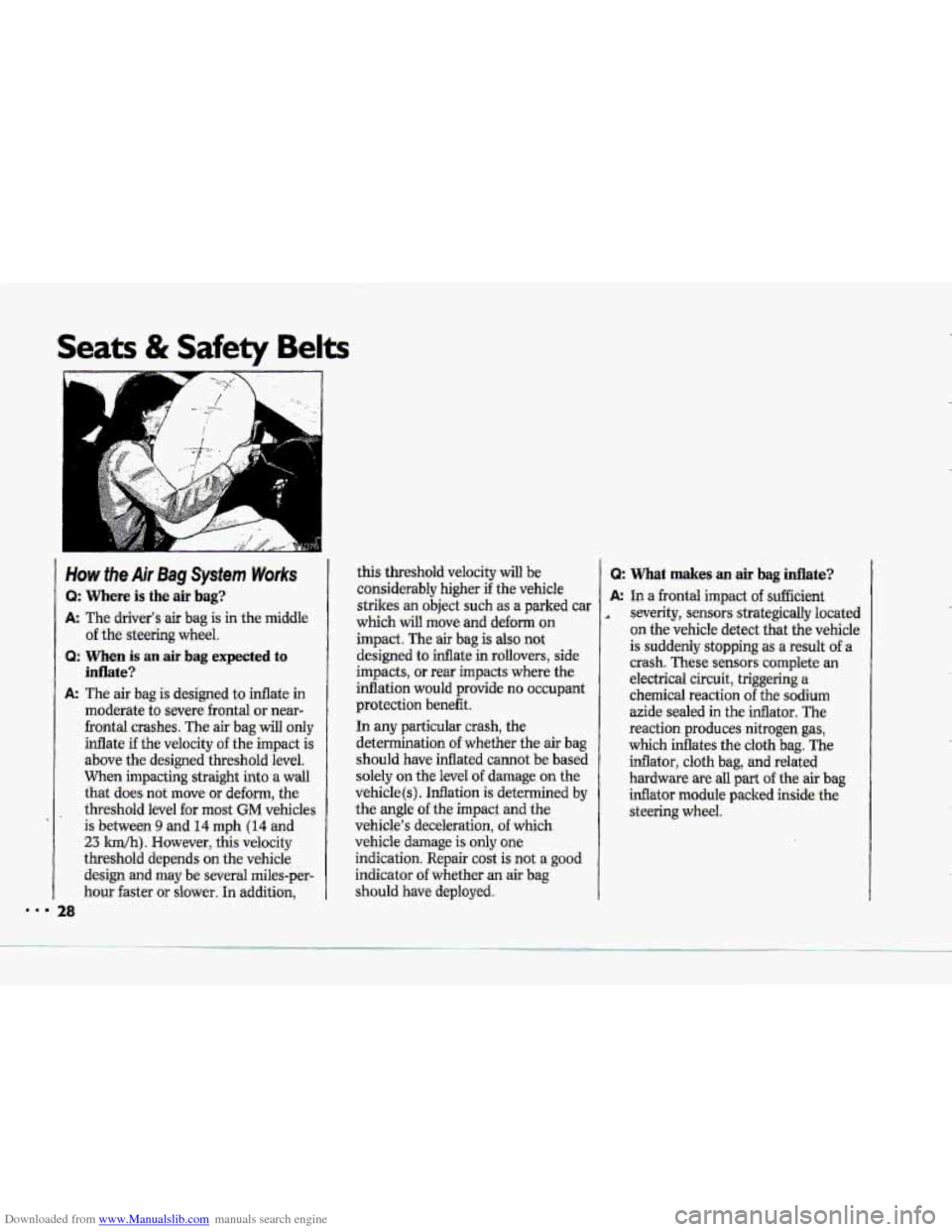
Downloaded from www.Manualslib.com manuals search engine Seats & Safety Belts
How the Air Bag System Works
Q: Where is the air bag?
A The driver's air bag is in the middle
of the steering wheel.
Q: When is an, air bag expected to
inflate?
A: The air bag is designed to inflate in
moderate to severe frontal
or near-
frontal crashes.
The air bag will only
inflate if the velocity of the impact is
above the designed threshold. level.
When. impacting straight irito a
wall
that does not move or deform, the
tbeshold level for most GM vehicles
is between 9 and 14 mph (14 and
23 ldh). However, thi,s velocity
threshold depends on
the vehicle
design
and may be several miles-per-
hour faster
or slower. In addition,
28
this threshold velocity will be
considerably higher if the vehicle
strikes an object such as a parked car
which
will move and ,deform on
impact. The air bag is also. not
designed to inflate in rollovers, side
impacts, .or rear impacls where the
inflation would provide no occupant
protection benefit.
In any
particular ;crash, the
determination
of whetherthe ail bag
should have inflated cannot be based
solely on the level of dgrnage on the
vehicle(s).. Inflation is-determined by
the angle of the impact and the
vehicle's deceleration,
of which
vehicle
damage is only one
indication. Repair cost is not a good
indicator of whether an air bag
should.
have deployed.
Q: What makes -an air bag inflate?
A: In a.frontal impact of sufficient
severity, sensors strategically located
an the vehicle. detect th& the vehicle
is. suddenly stopping .as a result of a
crash. These sensors complete an
electrical circuit, triggelling-
a
chemical reaction of the sodium-
az-ide sealed in the .inflator. The
reaction produces nitrogen
gas;
which inflates the cloth bag. The
inflator, cloth bag,
and related
hadwareare all
part of the air bag
inflator module packed inside the
steering wheel.
Page 81 of 370
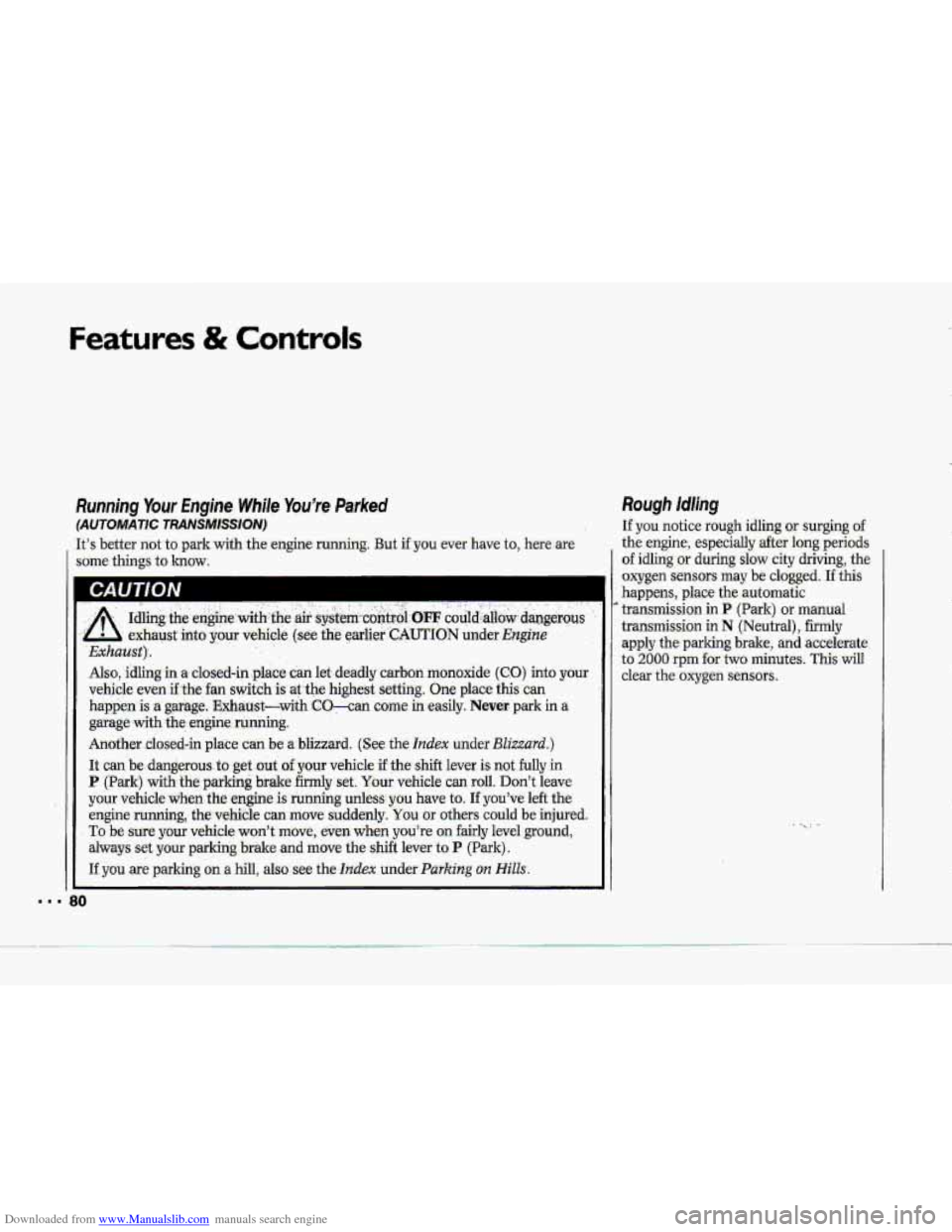
Downloaded from www.Manualslib.com manuals search engine Features & Controls
Running Your Engine While You're Parked
(AUTOMATIC TRANSMISSION)
It's better not to park.with the engine running. But if.you ever have to, here !are
some things to know.
'Exhaust)-.
Also, idring in a: closed-in-place -c'm let..deadly carbon monoxide (CO) into your
vehicle even %$he fan switch
is at.the highest setting. One place this can
happen'
is :a garage.. 'Exhaust-wiih CO-can corne heady. Never park in a
garage-with.fhe engine
running.
.Another closed-in place can be a blizzard. (See the Index under.BZizzai.d.)
It dan'b.e .dangerous.
to get .out of your vehicle if the shift lever is not fully in
P (Park) with:ihe.parking brake firmly set. Your vehicle can roll. Don't leave
your vehicle whenthe engine
is running unless you have to. If you've left the
engine running, the-.vehicle can move suddenly.
You or others. could be injured.
To be su-re your vehicle won't.move, even when you'-re on fairly level-ground,
aiways set
your .parking-brake and move the shift lever to P (Park).
If you are parking on .a hill, also. see the Index under Parking on Hi'ZZs.
Rough Idling-
If you notice rough idling or surging of
the engine, especially after long periods
of idling;.or during slow city driving, the
oxygen sensors
may be clogged. If this
happens, place the automatic
' transmission in P- (Park) .or manual
transmission in
N (Neutral), firmly
apply the parlcing brake, and accelerate.
to
2000 rprn for two minutes. This will
clear the oxygen sensors,
80
Page 91 of 370
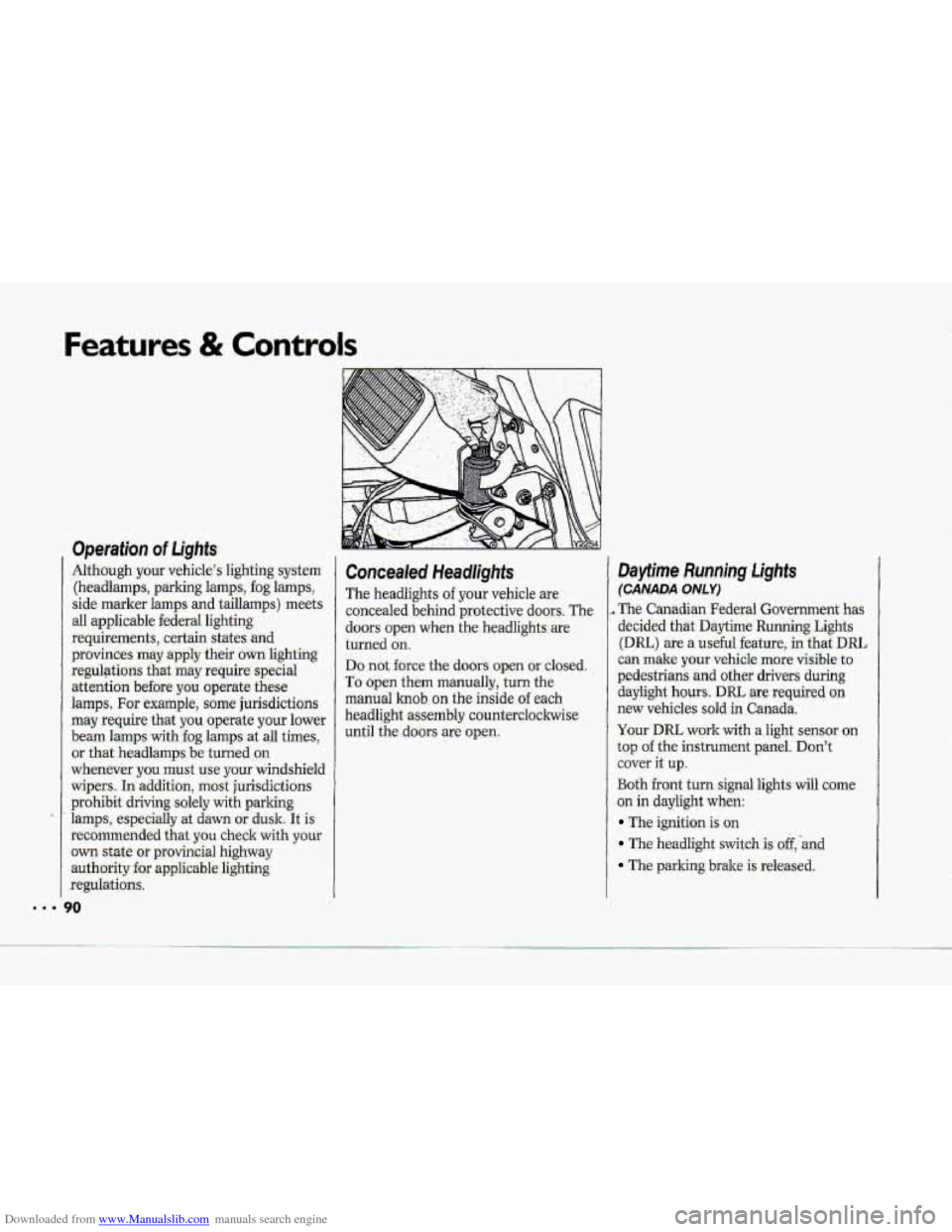
Downloaded from www.Manualslib.com manuals search engine us.
Features & Controls
Operation of Lights
Although your vehicle’s lighting system
(headlamps, parking lamps,
fog lamps,
side marker lamps and taillamps) meets
all applicable federal lighting
requirements, certain states
and
provinces may apply their own lighting
regulations that may require special
attention before
you operate these
lamps. For exampk, some jurisdictions
may require
that you operate your lower
beam lamps with fog lamps at all times,
or that headlamps be turned on
whenever
you must use your windshield
wipers. In addition, most jurisdictions
prohibit driving solely
with parking
lamps, especially at dawn or dusk It is
recommended that you check with your
own state or provincial highway
authority
for applicable lighting
regulations.
?O
Concealed Headlights
The headlights of your vehicle are
concealed behind protective doors. The
doors open when the headlights are
turned
on.
Do not force the doors open or closed.
To open them manually, turn the
manual hob
on the inside of each
headlight assembly countercloclnvise
until the doors are open.
Daytime Running Lights
(CANADA ONLY)
, The Canadian Federal Government has
decided that Daytime Running Lights
(Dm) are a useful feature, in that DRL
can make your vehicle more visible to
pedestrians and other drivers during
daylight hours.
DRL are required on
new vehicles sold in Canada,
Your
DRL work with a light sensor on
tap of the instrument panel. Don’t
1 come
cover
it
up.
Both front turn. signal lightswil
on in daylight when:
The ignition is on
The headlight switch.is &,-and
The parking brake is released.
Page 100 of 370
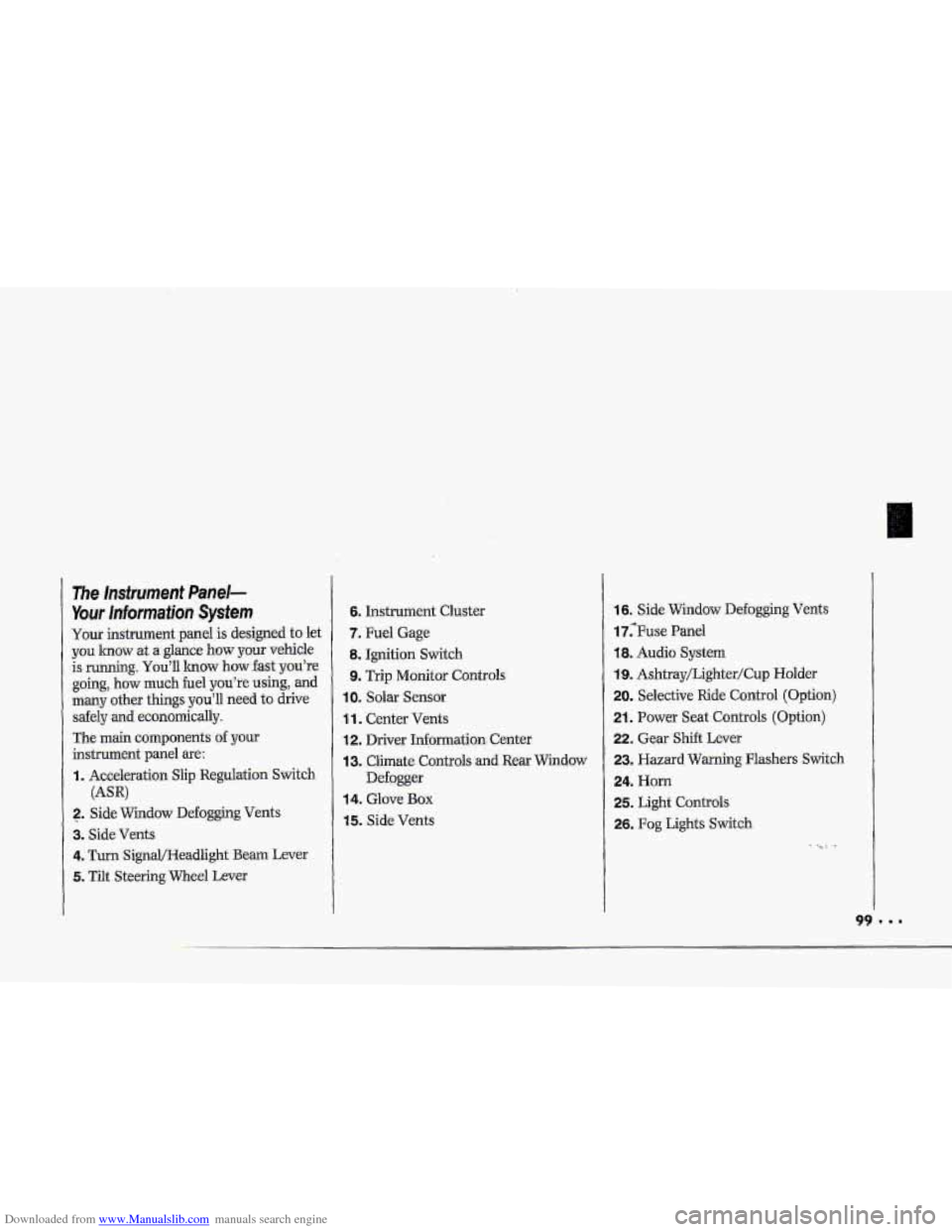
Downloaded from www.Manualslib.com manuals search engine i
P
r
F"
i I
The Insfrument Panel-
Your lnformaiion System
Your instrument panel is designed to let
you lmow at a glance how your vehicle
is running.
You'll lrnow how fast you're
going, how much fuel
you're using, and
many other things you'll need to drive
safely
and economically.
The main components
of your
instrument panel are:
I. Acceleration Slip Regulation Switch
2. ,Side Widow Defogging Vents
3. Side Vents
4. Turn SignQHeadlight Beam Lever
5. Tilt Steering Wheel Lever
(AW
6. Instrument Cluster
7. Fuel Gage
8. Ignition Switch
9. Trip Monitor Controls
IOm Solar Sensor
1 1. Center Vents
12. Driver Information. Center
13. Climate Controls and Rear Window
Defogger
14. Glove Box
15. Side Vents
16. Side Window Defogging Vents
17;Fuse Panel
18. Audio System
19. Ashtray/Lighter/Cup Holder
20. Selective Ride Control (Option)
21. Power Seat Controls (Option)
22. Gear Shift Lever
23. Hazard Warning Flashers Switch
24. Horn
25. Light Controls
26. Fog Lights Switch
-. .
Page 114 of 370
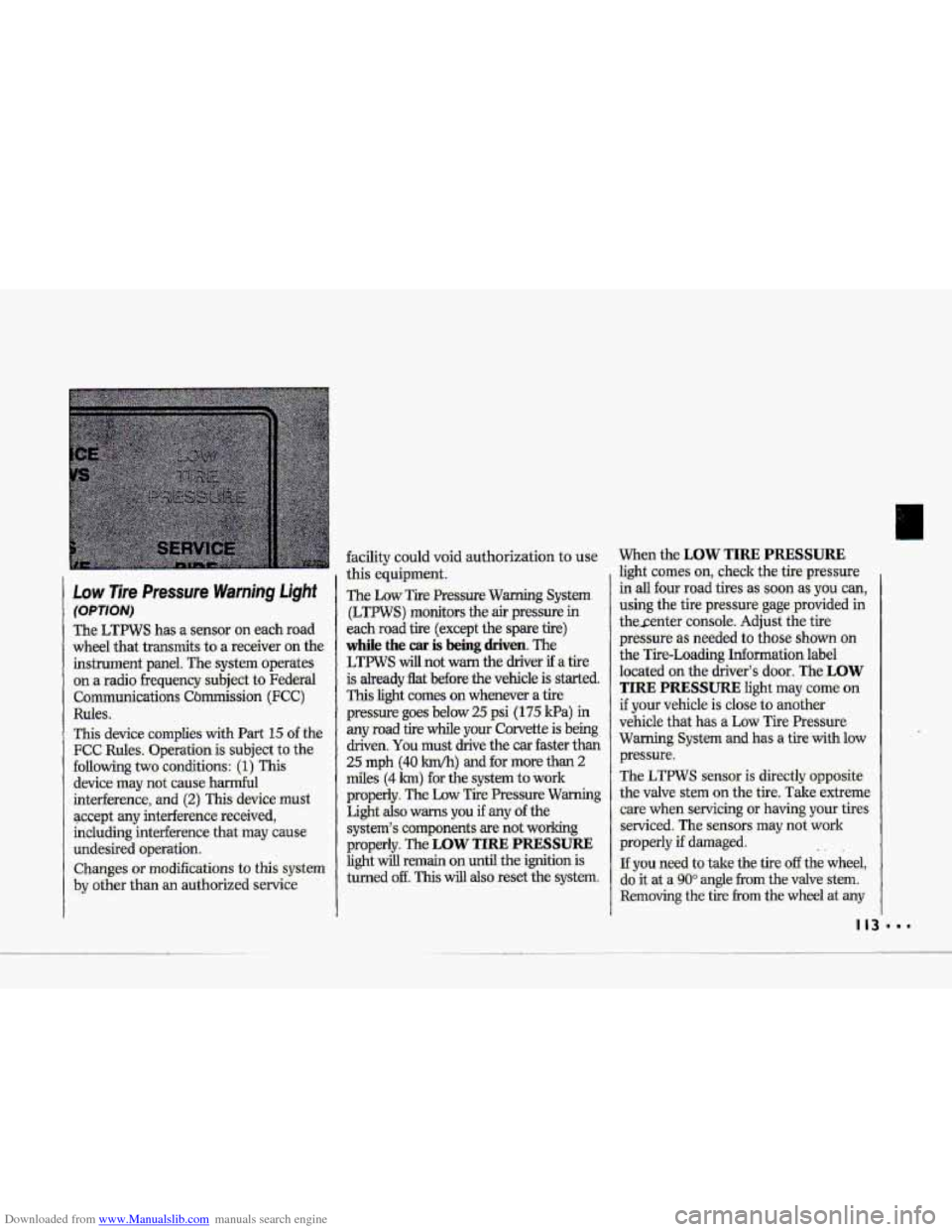
Downloaded from www.Manualslib.com manuals search engine P
Low 7ire Pressure Warning Light
(OPTION)
The LTPWS has a sensor 'on each road
wheel that transmits-to
a receiver on the
instrument panel.
The system operates
on a radio frequency subject
to Federal
Communications Cbmission
(FCC)
Ruks.
This device complies with Part 15 of the
FCC Rules. Operation is subject to the
following
two conditions: (1) This
device may not cause harmful
interhence,
and (2) This device.must
accept
any interhence received,
including interference that-may cause
undesired operation.
Changes or modifications to- this system
by other than an authorized service
facility could void authorization to use
this equipment.
The Low Tre Pressure Warning System
(LTPWS) monitors the
air pressure in
each road tire (except the spare tire)
while the car is being driven. The
LTFWS will not warn the driver if a tire
is
already flat before the vehicle is started.
This light comes on whenever a tire
pressure
goes below 25 psi (I 75 Ha) in
any road tire while your Corvette is being
driven.
You must drive the car faster than
25 mph (40 km/h) and for more than 2
miles (4 h) -for the system to work
properly.
The Low Tire Pressure Warming
Light also warns you if any of the
system's comp.onents-are not working
properly. The
LOW TIRE PRESSURE
light will remain on until the ignition is
turned
off. This will also reset the system.
When the LOW TIRE PRESSURE
fight comes on, check the tire -pressure
.in
all four road tires as soon as you can,
using the
tire pre:ssure gage.provided in
thesenter console. Adjust the tire
pressure as needed to those shown on
the Tire-Loading Information label
10-cated
on the driver's door, The LOW
TIRE PRESSURE light may come on
if your vehicle is close to aaother
vehicle that has
a Low Tire Pressure
Warning System
and has a tire-with low
pressure.
The LTPWS sensor is directly opposite
the valve stem on the tire. Take extreme
care when servicing or
having your tires
serviced. The sensors may not work
properly
if damaged.
If you need to take the tire off the wheel,
do it at a
90" angle from the valve stem.
Removing the tire from the wheel at any
.. 1
Page 115 of 370
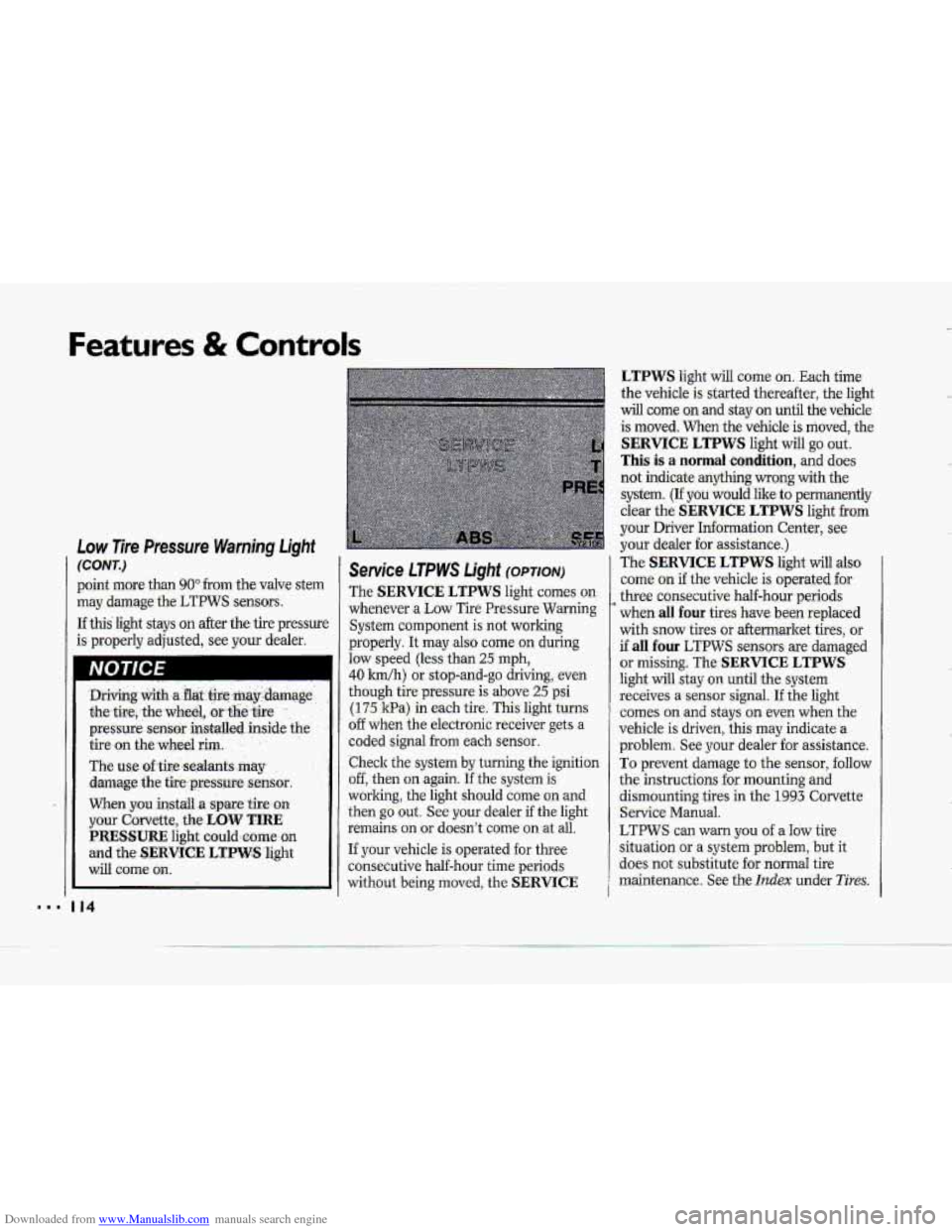
Downloaded from www.Manualslib.com manuals search engine Features & Contro1.s
point more than 90" from the valve stem
may damage the LTPWS sensors..
If this light stays on after the tire pressure
is properly adjusted, see your dealer.
I14
Service LTPWS Light (OPTION)
The SERVICE LTPWS light comes on
whenever a Low Tire PressureWrtming
System component is not working
properly. It
may also come on during
law speed (less than 25 rnph,
40 Idh) or. stop-and-go driving, even
though tire pressure is above 25 psi
(175 kPa-) in each tire. This light turns
o€f when the electronic receiver gets a
coded signal
from each sensor..
.Check the system
by turning the ignition
off, then on again. If'lhe system is
worling, the light should come on-and
then go out. See your dealer if the light
remains on
or doesn'.t come on .at ail.
If your vehicle is operated for three
consecutive half-hour time periods
without being moved,
the .. SERVICE
LTPWS light will come on. Each time
the vehicle
is started thereafter, the light
will come mand stay on until the vehicle.
is moved. When the vehicle
is moved, the-
SERVICE LTPWS light will go out.
This is a normal condition, and does
not indicate
anything-wrong with the
system.
(If you would Iilre to permanently
clear the
SERVICE LTPWS light from
your Driver Information Center, see
your dealer for assistance.)
The
SERVICE LTPWS light will also
corne. on if.the vehicle is operated for
three consecutive half-hour periods-
when
,dl four tires- have been replaced
with
snow tires or aftermarket tires, or
if all four LT-PWS sensors. are damaged
or missing. The SERVICE LTPWS
light will stay o.n until the system
receives
a sensor signal. I€ the light
'comes on and stays on even when the
vehicle is driven, this may .indicate
a
problem. See your dealer for assistance.
To prevent damage to the sensor, follow
the instructions
for mounting and
dismounting tires in
the 1993 Corvette,
Service Manua.1.
LTPWS can warn you of a Idw tire
situation-or
a system problem, but it
-does not substitute .foT.norrnal tire
maintenance. See the
Itzdex under Tires;
Page 141 of 370
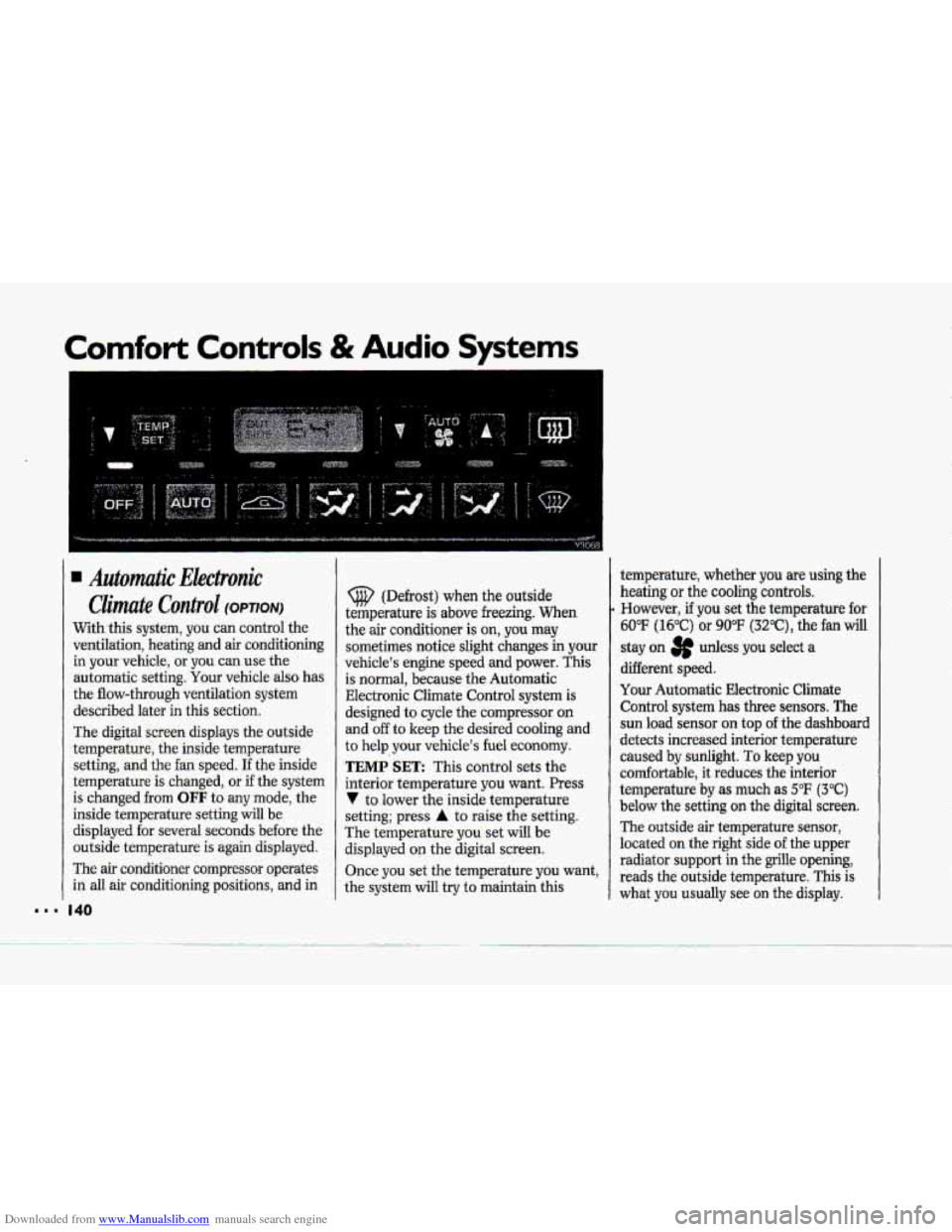
Downloaded from www.Manualslib.com manuals search engine Comfort Controls & Audio Systems
... I..
1. 140
Automutic Ekctronic
Climate Control (OPTION)
With this system, you can control the
ventilation, heating
and air conditioning
in your vehicle, or you can use the
automatic setting.
Your vehicle also has
the flow-through ventilation system
described later
in this section.
The digital screen displays the outside
temperature, the inside temperature
setting, and the fan speed.
If the inside
temperature is changed,
or if the system
is changed from
OFF to any mode, the
inside temperature setting will be
displayed for several seconds before the
outside temperature is again displayed.
The
air conditioner compressor operates
in all air conditioning positions, and in
(@ (Defrost) when the outside
temperature is above freezing.
When
the air conditioner is on, you may
sometimes notice slight changes in your
vehicle's engine speed and power. This
is normal, because the Automatic
EIectronic Climate Control system
is
designed to cycle the compressor on
and off to keep the desired cooling and
to
help your vehicle's fuel economy.
TEMP SET: This control sets the
interior temperature you want. Press
V to lower the inside temperature
setting; press
A to raise the setting.
The temperature
you set will be
displayed on the digital screen.
Once you set the temperature you want,
the system will try to maintain this temperature,
whether
you are using the
heating
or the cooling controls.
However, if you set the temperature for
60°F (16°C) or 90°F (3Z°C), the fan will
stay on 3p udess you select a
different speed.
Your Automatic Electronic Climate
Control system
has three sensors. The
sun load sensor on top of the dashboard
detects increased interior temperature
caused by sunlight.
To keep you
comfortable, it reduces the interior
temperature
by as much as 5°F (3°C)
below the setting on the digital screen.
The outside air temperature sensor,
located on the right
side of the upper
radiator support
in the grille opening,
reads the outside temperature.
This is
what you usually see on the display.
Page 142 of 370
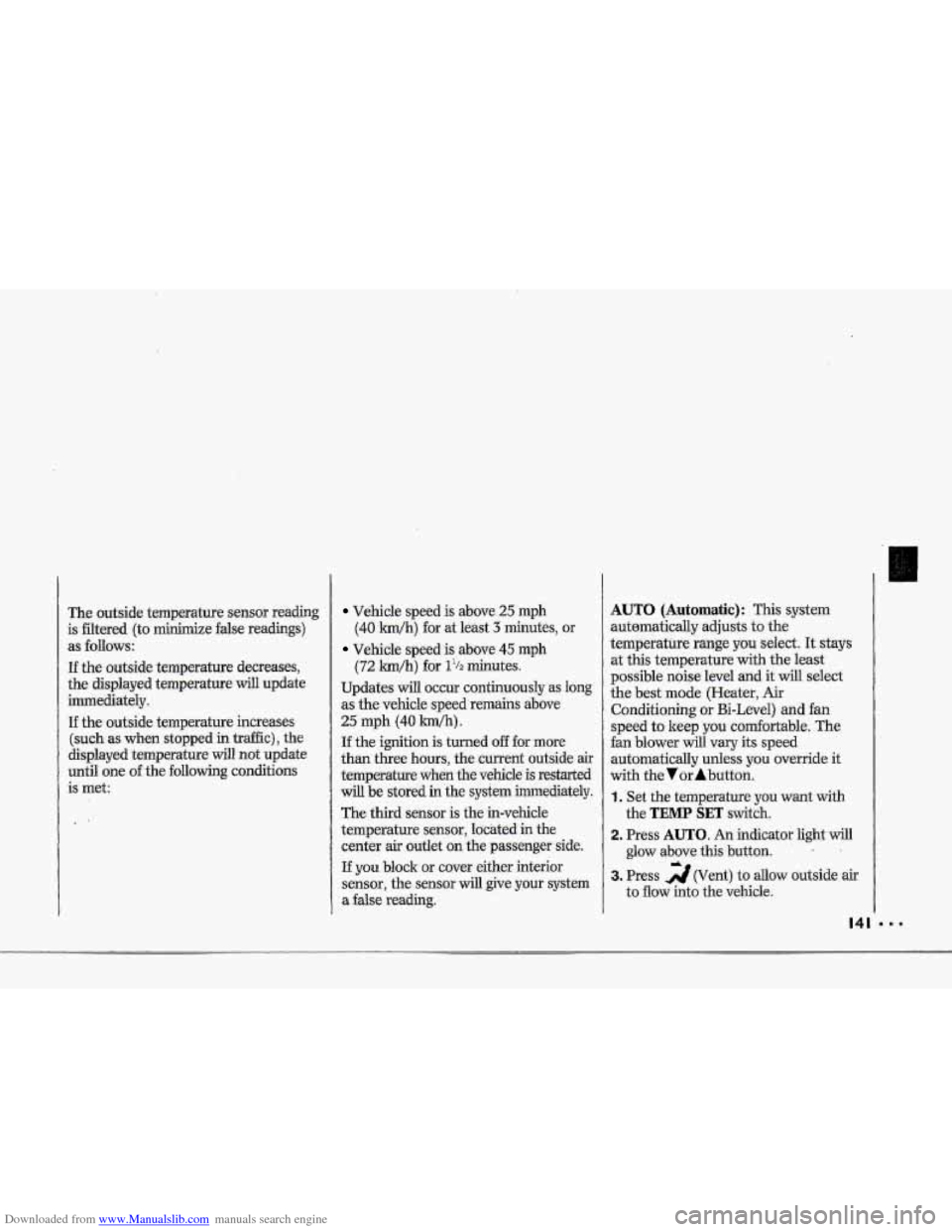
Downloaded from www.Manualslib.com manuals search engine 4
$"
i i
I i
?- i
i
i I
r I
r"
!
The outside ternperatufe sensor reading
is filtered (to minimize false readings)
as follows:
If- the outside temperature decreases,
the -&splayed temperature
will update
immediately.
I€- the outside temperature increases
(such as when stopped in traffic), the
displayed temperature will not update
until one
of the following eonditiom
is met:
Vehicle speed is above 25 mph
Vehicle speed 'is above 45 mph
Updates will occur continuously as long
as the vehicle speed remains above
25 mph (40 Wh).
zf the ignition is turned off for more
than three hours, the current outside air
tempepature when the vehicle is restarted
will be stored in the system immediately.
The third sensor
is the in-vehicle
tempefature sensor, located
in-the
center air outlet on the passenger side.
If you block or cover either interior
sensor, the sensor
will give your system
a false reading.
(40 ,nn/h) for at least 3 minutes, or
(72 krn/h) for 1% minutes.
AUTO (Automatic): This system
autmnatically
adjusts to the
temperature range you select.
rt stays
at. this temperature
with the least
possible noise level
and it will select
the best mode (Heater,
Air
Conditioning or Bi-Level) and fm
speed to keep you comfortable. The
fan blower
will vary its speed
automatically unless you ovenide
it
with theVqrAbutton,
1 .I Set the temperature you want with
2. Press AUTO. An indicator light will
3. Press A (Vent) to allow outside. air
the
TEMP SET switch.
glow above
this.hutton.
to
flaw into the vehicle.
d
Page 244 of 370
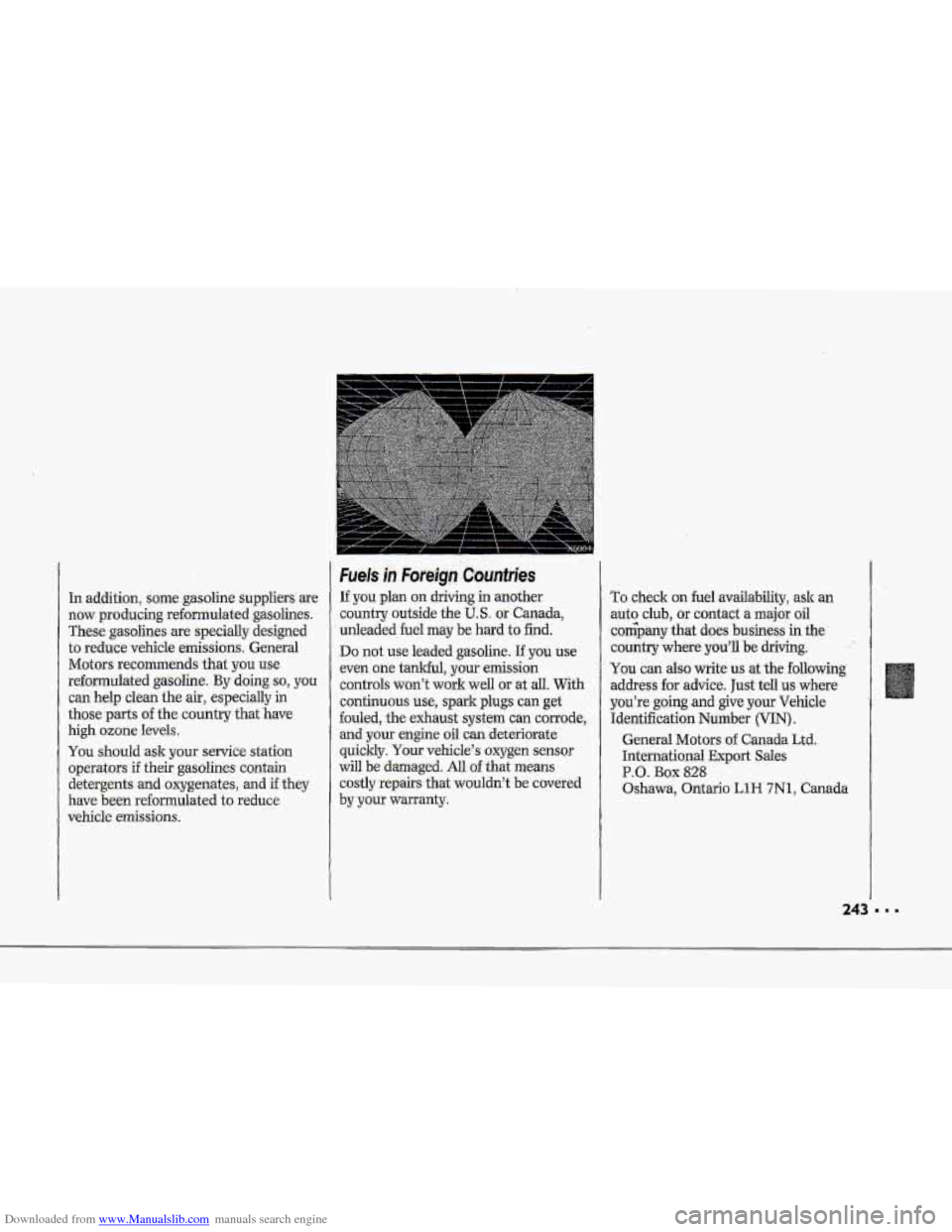
Downloaded from www.Manualslib.com manuals search engine i
i.R", I
F". i !
P !
In addition, some gasoline suppliers are
now producing reformulated gasolines.
These gasolinesare specially designed
to reduce vehicle emissions. General
Motors recommends that
you use
reformulated gasoline. By doing so, you
can help clean the air, especially in
those parts of the country that have
high ozone levels.
You should.aslc your service station
operators
if their gasolines contain
detergents and oxygenates, and
if they
have been reformulated to reduce
vehicle
emissions.
Fuels in Foreign Countries
If you plan on drivingh another
country outside the
U.S. or Canada,
unleaded
fuel may be hard to find.
Do not use leaded gasoline. If you use
even
one tankful, your emission
controls won't
work well or at all. With
continuous use,
spa& plugs can get
fouled,
the exhaust system can corrode,
and
your engine oil can deteriorate
quickly. Your vehicle's oxygen sensor
will be damaged.
All ofthat means
costly repairs that wouldn't be covered
by
your warranty.
To check on fuel availability, ask an
auto club,
or contact a major oil
cuspany that does business in the
countqrwhere you'll
be driving.
You can also write us at ,the following
address
for advice. Just tell us where
you're
going and give your Vehicle
Identification Number
(VIN) .
General Motors of Canada Ltd.
International Export Sales
P.O. Box 828
Oshawa, Ontario LlH 7N1, Canada
Page 309 of 370
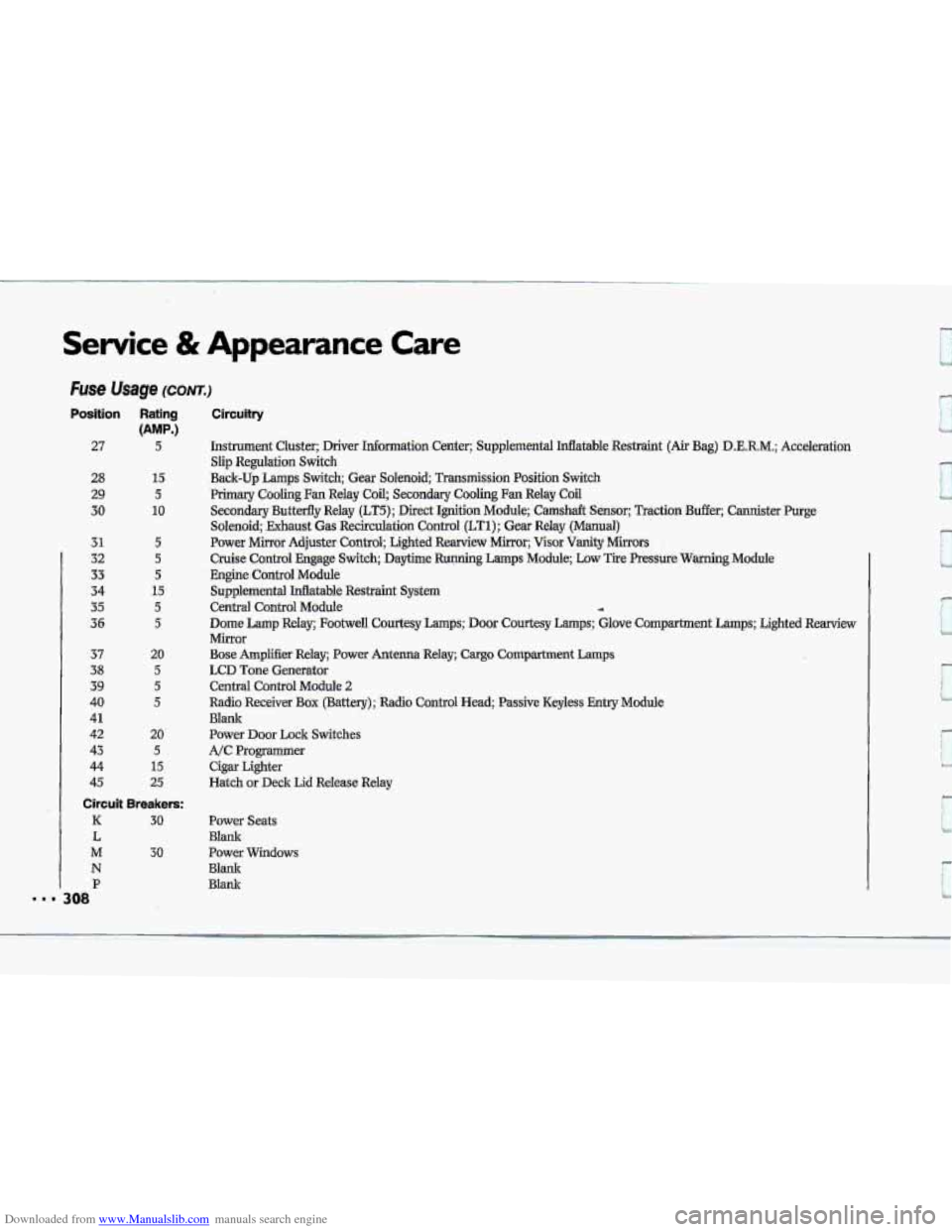
Downloaded from www.Manualslib.com manuals search engine Service & Appearance Care
Fuse Usage (CONT.)
Position Rating
(AMP.)
27 5
28 15
29 5
30 10
31 5
32 5
33 5
34 15
35 5
36 5
37 20
38 5
39 5
40 5
41
42 20
43 5
44 15
45 25
Circuit Breakers:
K 30
L
M
N
P
3.0
1 308
Circuitry
Instrument Cluster; Driver Information Center; Supplemental Inflat\
able Restraint (Air Bag) D.E.R.M.; Acceleration
Slip Regulation
Switch
Back-up Lamps Switch Gear Solenoid; Transmission Position Switch
Primary Coaling Fan Relay Coil; Secondary Cooling Fan Relay Coil '
Secondary Butterfly Relay (LT5); Direct Ignition Module; Camshaft Sensor; Traction Buffer; Cannist\
er Purge
Solenoid; Exhaust
Gas Recirculation Control (LT1); Gear Relay (Manual)
Power
Mirror Adjuster Control; Lighted Rearview Mirror; Visor Vanity Mirrors
Cruise Control Engage Switch Daytime Running Lamps Module; Low Tire Pressure Warning Module
Engine Control Module
Supplemental Inflatable Restraint System
Central Control Module
Dome Lamp Relay; Footwell Courtesy Lamps; Do.0~ Cpurtesy Lamps; Glove Compartment Lamps; Lighted Rearview
Mirror
Bose
Amplifier Relay; Power Antenna Relay; Cargo Compartment Lamps
LCD Tone Generator
Central Control Module
2
Radio Receiver Box (Battery); Radio Control Head; Passive Keyless Entry Module
Blank
Power Door Lock Switches
A/C Programmer
Cigar Lighter
Hatch or Deck
Lid Release Relay
4
Power Seats
Blank
Power Windows
Blank
Blank